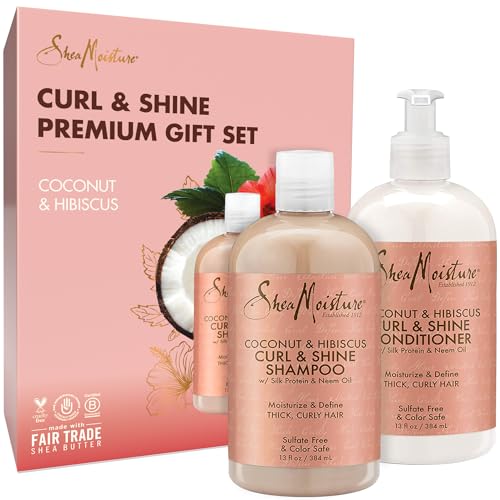
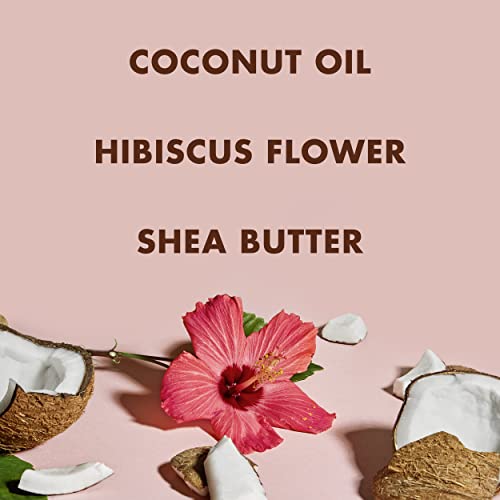
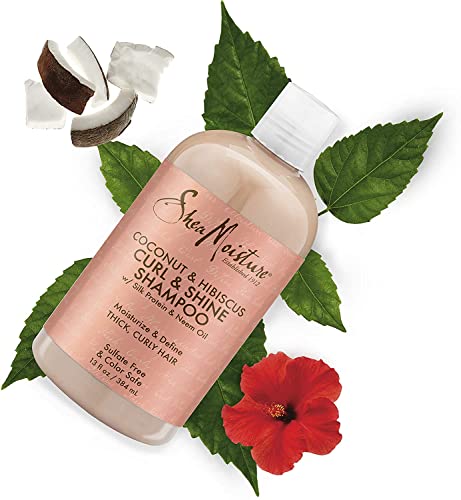


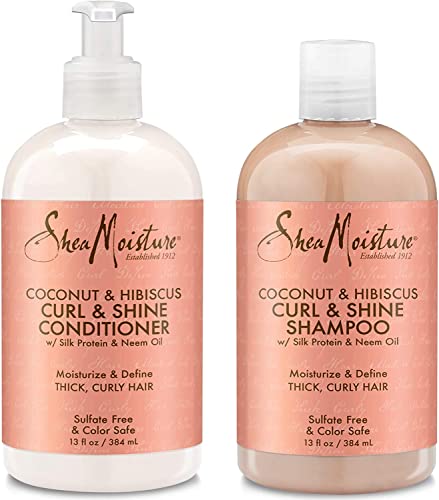
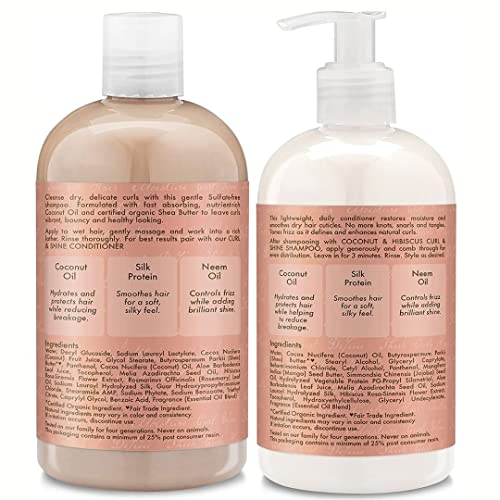
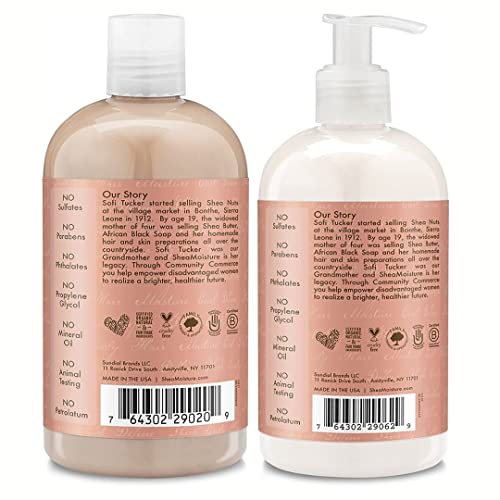
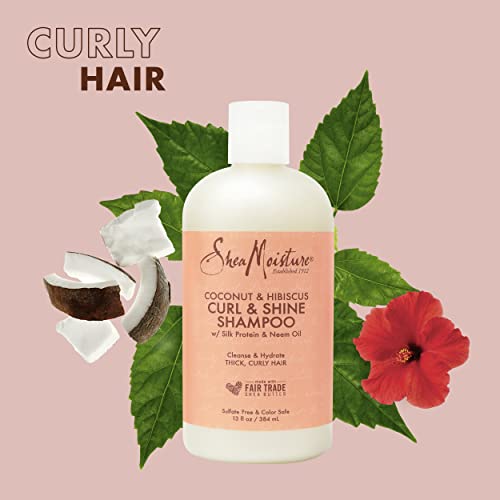
Shea Moisture Shampoo & Conditioner Set - Frizz Control, Moisturizing Coconut Oil - 13 Fl Oz Each


Behentrimonium Chloride
High RiskBehentrimonium chloride is a quaternary ammonium compound primarily used as a conditioning agent in hair and skin care products. It functions as an emulsifier and surfactant, helping to improve texture and manageability of hair.
Sustai Insights
Behentrimonium chloride offers functional benefits as a hair conditioner and emulsifier. However, it is associated with moderate allergenic potential and has high use restrictions due to regulatory concerns. It poses low risks for carcinogenicity and developmental toxicity but has been noted for neurotoxicity. Environmental risks include potential pollution and low biodegradability. Overall, the ingredient is assessed as high risk, and users should consider alternatives such as natural conditioners.
Glyceryl Undecylenate
Medium RiskGlyceryl undecylenate is an ester of glycerin and undecylenic acid, commonly used as a skin-conditioning agent and emulsifier in cosmetic formulations. It aids in improving the texture and spreadability of products, contributing to their overall performance.
Sustai Insights
Glyceryl undecylenate offers functional benefits as an effective emulsifier and skin-conditioning agent. It is generally recognized as safe with low concerns regarding carcinogenicity, allergies, and reproductive toxicity. However, moderate use restrictions exist, and regulatory advisories should be considered. Environmental risks are minimal, with no significant pollutant or bioaccumulation potential noted. Overall, the risk assessment indicates a medium-level risk, making it essential to follow safe usage practices and consider alternatives like glycerin or natural oils for sustainability.
Stearyl Alcohol
Low RiskStearyl alcohol is a compound produced from the hydrogenation of stearic acid, commonly used in cosmetic formulations as an emulsifier and thickening agent. It helps stabilize products by blending oil and water phases, enhancing texture and consistency.
Sustai Insights
Stearyl alcohol provides functional benefits as an emulsifier and stabilizer, contributing to improved product texture. It is generally regarded as safe with low concerns for cancer, allergies, and reproductive toxicity. However, it may cause moderate skin, eye, or respiratory irritation. Regulatory bodies do not impose significant restrictions, indicating a low overall risk. While it poses minimal health and environmental hazards, caution is advised for sensitive individuals. Alternatives like cetyl alcohol or plant-based emulsifiers may offer safer options for formulators.
Tocopherol, D Alpha
Low RiskTocopherol, specifically d-alpha tocopherol, is a naturally occurring form of Vitamin E. It is commonly used in cosmetic and personal care products primarily for its antioxidant properties, helping to protect formulations from oxidation and extend shelf life.
Sustai Insights
D-alpha tocopherol provides effective antioxidant benefits, contributing to product stability. It is sustainably sourced and generally regarded as safe, with low concerns regarding carcinogenicity, allergies, and reproductive toxicity. However, there are minor concerns about endocrine disruption. Regulatory bodies have not imposed significant restrictions, indicating low overall risk. Recommended usage practices include adhering to established safe concentration thresholds. Alternatives, such as other forms of Vitamin E or plant-based antioxidants, may also be considered.
Butyrospermum Parkii (Shea) Butter
Low RiskButyrospermum parkii (shea) butter is a vegetable fat derived from the nuts of the shea tree. It is commonly used in cosmetic formulations for its emollient properties, providing moisture and improving skin texture. Additionally, shea butter is known for its ability to enhance the stability of products and deliver a creamy texture.
Sustai Insights
Shea butter offers functional benefits as an effective moisturizer, enhancing skin barrier function and texture. It is sustainably sourced and biodegradable, contributing to eco-friendliness. Health-wise, it is associated with low risks for carcinogenicity, allergies, and reproductive toxicity. Environmental impacts are minimal, with no significant pollutant potential identified. Regulatory assessments indicate no current restrictions. Overall, the ingredient presents a low risk, making it a favorable choice in cosmetic formulations.
Mangifera Indica (Mango) Seed Butter
Low RiskMangifera indica (mango) seed butter is a fat extracted from the seeds of the mango fruit. It is commonly used in cosmetic formulations for its emollient and moisturizing properties, providing a smooth texture and enhancing product stability.
Sustai Insights
Mango seed butter offers functional benefits such as effective moisturization and skin conditioning, derived from its fatty acid profile. It is considered low risk regarding health concerns, with minimal allergenic potential and no significant environmental hazards. Regulatory agencies have not imposed restrictions on its use. Overall, the ingredient is assessed as low risk, making it a suitable option for various cosmetic products. Alternatives include other plant-based butters like shea or cocoa butter for similar properties.
Glyceryl Caprylate
Low RiskGlyceryl caprylate is a monoester of glycerin and caprylic acid, commonly used in cosmetics and personal care products as an emulsifier and skin-conditioning agent. It helps stabilize formulations and improve the texture and feel on the skin.
Sustai Insights
Glyceryl caprylate offers functional benefits as an effective emulsifier and skin-conditioning agent, enhancing product performance. It is biodegradable and considered sustainably sourced. Health risks are low, with minimal concerns regarding carcinogenicity, allergenic potential, and endocrine disruption. Environmental risks are also low, with no significant pollutant or bioaccumulation potential identified. Regulatory status is favorable, with no major restrictions. Overall, glyceryl caprylate maintains a low risk profile, making it a suitable ingredient for use in cosmetic formulations.
Hydrolyzed Silk
Low RiskHydrolyzed silk is a form of silk protein that has been broken down into smaller peptides, enhancing its ability to be absorbed by the skin and hair. It is commonly used in cosmetic and personal care products for its moisturizing and film-forming properties, contributing to improved texture and hydration.
Sustai Insights
Hydrolyzed silk offers functional benefits such as enhancing moisture retention and providing a silky feel to formulations. It is generally considered low risk for health concerns, with minimal allergenic potential and no significant reproductive toxicity reported. Environmentally, it poses low risks, as it is not bioaccumulative or a known pollutant. Regulatory bodies have not issued significant warnings. Overall, it is a low-risk ingredient. Safe usage involves avoiding excessively high concentrations, and alternatives include plant-based proteins like hydrolyzed wheat or rice.
Panthenol, D
Low RiskPanthenol, also known as provitamin B5, is a humectant commonly used in cosmetic and personal care products. It functions primarily as a moisturizer, enhancing skin hydration and improving the appearance of hair by imparting shine and softness.
Sustai Insights
Panthenol is effective in retaining moisture, thus providing functional benefits for skin and hair care products. It is generally recognized as safe, with low concerns regarding carcinogenicity, allergies, and developmental toxicity. However, potential cumulative exposure from multiple sources exists. Environmental risks are minimal, and it is not bioaccumulative. Regulatory bodies have not issued significant warnings; therefore, the overall risk level is assessed as low. For optimal use, it is recommended to follow product guidelines, and alternatives such as glycerin may also be considered for moisturizing effects.
Cetyl Alcohol
Low RiskCetyl alcohol is a long-chain organic alcohol commonly used in cosmetic formulations. It serves as an emollient, emulsifier, and thickening agent, enhancing the texture and stability of products. Cetyl alcohol is derived from natural sources, such as coconut or palm oil, and is often included in creams, lotions, and hair conditioners.
Sustai Insights
Cetyl alcohol offers functional benefits as an emollient and emulsifier, improving product texture and stability. It is biodegradable and sourced from renewable materials, contributing to sustainability. Health risks are minimal, with low concerns for carcinogenicity, allergies, or reproductive toxicity. Environmental impact is also low, with no significant pollutant or bioaccumulation potential. Regulatory bodies have not placed restrictions on its use, indicating a favorable safety profile. Overall, cetyl alcohol is assessed as low risk, and safe usage practices include ensuring proper formulation concentrations.
Water
Low RiskWater is a clear, colorless liquid essential for various biological processes. It serves as a solvent in formulations, facilitating the dissolution of other ingredients and enhancing product texture and application. Additionally, water plays a crucial role in hydration and is a key component in many cosmetic and personal care products.
Sustai Insights
Water is an effective solvent and hydrator, contributing to the texture and efficacy of formulations. It is biodegradable and generally regarded as safe, with low concerns regarding carcinogenicity, allergies, and reproductive toxicity. However, excessive water usage can lead to environmental concerns, particularly regarding resource depletion. Regulatory bodies do not impose restrictions on water use in cosmetics. Overall, the risks associated with water are low, making it a safe and essential ingredient.
Hydroxyethylcellulose
Low RiskHydroxyethylcellulose is a modified cellulose polymer used primarily as a thickening agent and stabilizer in various cosmetic and personal care products. It is soluble in water and helps to improve the texture and viscosity of formulations, enhancing their usability and performance.
Sustai Insights
Hydroxyethylcellulose offers functional benefits such as effective thickening and stabilization in formulations, contributing to product texture. It is generally considered low-risk in terms of health, with minimal concerns regarding carcinogenicity, allergens, or reproductive toxicity. Environmentally, it poses low risks and is not known to be bioaccumulative. Regulatory bodies have not imposed significant restrictions on its use. Safe practices include adhering to recommended concentrations, and while alternatives exist, hydroxyethylcellulose remains a low-risk ingredient overall.
Cocos Nucifera (Coconut) Oil
Low RiskCocos Nucifera (Coconut) Oil is derived from the kernels of the coconut palm. It is primarily used in cosmetic formulations for its emollient and moisturizing properties, making it suitable for skin and hair care products.
Sustai Insights
Coconut oil serves as an effective moisturizer and emollient, promoting skin hydration and softness. It is sustainably sourced and biodegradable. Health risks are minimal, with low concerns regarding carcinogenicity, allergens, and reproductive toxicity. Environmental impact is also low, as it does not contribute significantly to pollution or bioaccumulation. Regulatory bodies have not issued restrictions on its use. Overall, coconut oil presents a low risk for health and environmental concerns, making it a safe ingredient in cosmetic products.
Azadirachta Indica (Neem) Seed Oil
Low RiskAzadirachta indica (neem) seed oil is derived from the seeds of the neem tree. It is commonly used in cosmetic and personal care products for its potential properties as an emollient and its traditional use in herbal medicine. Its applications include skin care, hair care, and as an insect repellent.
Sustai Insights
Neem seed oil offers functional benefits such as moisturizing and potential antimicrobial properties, making it useful in personal care formulations. It is considered sustainably sourced and biodegradable. Health risks are low, with minimal concerns regarding carcinogenicity, allergies, or reproductive toxicity. Environmental risks are also low, with no significant pollutant or bioaccumulation potential. Regulatory status shows no current restrictions. Overall, it is assessed to have a low risk, making it a favorable choice in formulations.
Hydrolyzed Vegetable Protein Pg Propyl Silanetriol
Low RiskHydrolyzed vegetable protein PG-propyl silanetriol is a modified protein derived from vegetable sources, used in cosmetic formulations primarily for its conditioning properties. It acts as a moisturizing agent and film-forming agent, enhancing the texture and feel of products.
Sustai Insights
Hydrolyzed vegetable protein PG-propyl silanetriol offers functional benefits as a moisturizing and conditioning agent in personal care products. It is considered low risk for health concerns, with minimal evidence of carcinogenicity, allergies, or reproductive toxicity. Environmentally, it poses low pollutant and bioaccumulation risks, with no current regulatory restrictions. Safe usage practices involve adhering to product guidelines, and while alternatives exist, they may not replicate all functional benefits. Overall, this ingredient is assessed as low risk based on current scientific consensus.
Simmondsia Chinensis (Jojoba)
Low RiskSimmondsia chinensis, commonly known as jojoba, is an oil derived from the seeds of the jojoba plant. It is commonly used in cosmetic formulations for its moisturizing properties, acting as an emollient and skin conditioning agent.
Sustai Insights
Jojoba oil offers functional benefits such as effective skin moisturization and is biodegradable, with sustainable sourcing practices. Health risks are low, with minimal concerns regarding carcinogenicity, allergies, and reproductive toxicity. Environmental impact is negligible, with no pollutant or bioaccumulation potential. Regulatory status is favorable with no significant restrictions noted. Overall, it is assessed as low risk, and safe usage practices should be maintained. Alternatives include other plant-derived oils like argan or almond oil, which may provide similar benefits.
Stearyl Alcohol
Low RiskStearyl alcohol is a compound produced from the hydrogenation of stearic acid, commonly used in cosmetic formulations as an emulsifier and thickening agent. It helps stabilize products by blending oil and water phases, enhancing texture and consistency.
Sustai Insights
Stearyl alcohol provides functional benefits as an emulsifier and stabilizer, contributing to improved product texture. It is generally regarded as safe with low concerns for cancer, allergies, and reproductive toxicity. However, it may cause moderate skin, eye, or respiratory irritation. Regulatory bodies do not impose significant restrictions, indicating a low overall risk. While it poses minimal health and environmental hazards, caution is advised for sensitive individuals. Alternatives like cetyl alcohol or plant-based emulsifiers may offer safer options for formulators.
Tocopherol, D Alpha
Low RiskTocopherol, specifically d-alpha tocopherol, is a naturally occurring form of Vitamin E. It is commonly used in cosmetic and personal care products primarily for its antioxidant properties, helping to protect formulations from oxidation and extend shelf life.
Sustai Insights
D-alpha tocopherol provides effective antioxidant benefits, contributing to product stability. It is sustainably sourced and generally regarded as safe, with low concerns regarding carcinogenicity, allergies, and reproductive toxicity. However, there are minor concerns about endocrine disruption. Regulatory bodies have not imposed significant restrictions, indicating low overall risk. Recommended usage practices include adhering to established safe concentration thresholds. Alternatives, such as other forms of Vitamin E or plant-based antioxidants, may also be considered.
Butyrospermum Parkii (Shea) Butter
Low RiskButyrospermum parkii (shea) butter is a vegetable fat derived from the nuts of the shea tree. It is commonly used in cosmetic formulations for its emollient properties, providing moisture and improving skin texture. Additionally, shea butter is known for its ability to enhance the stability of products and deliver a creamy texture.
Sustai Insights
Shea butter offers functional benefits as an effective moisturizer, enhancing skin barrier function and texture. It is sustainably sourced and biodegradable, contributing to eco-friendliness. Health-wise, it is associated with low risks for carcinogenicity, allergies, and reproductive toxicity. Environmental impacts are minimal, with no significant pollutant potential identified. Regulatory assessments indicate no current restrictions. Overall, the ingredient presents a low risk, making it a favorable choice in cosmetic formulations.
Glyceryl Undecylenate
Medium RiskGlyceryl undecylenate is an ester of glycerin and undecylenic acid, commonly used as a skin-conditioning agent and emulsifier in cosmetic formulations. It aids in improving the texture and spreadability of products, contributing to their overall performance.
Sustai Insights
Glyceryl undecylenate offers functional benefits as an effective emulsifier and skin-conditioning agent. It is generally recognized as safe with low concerns regarding carcinogenicity, allergies, and reproductive toxicity. However, moderate use restrictions exist, and regulatory advisories should be considered. Environmental risks are minimal, with no significant pollutant or bioaccumulation potential noted. Overall, the risk assessment indicates a medium-level risk, making it essential to follow safe usage practices and consider alternatives like glycerin or natural oils for sustainability.
Mangifera Indica (Mango) Seed Butter
Low RiskMangifera indica (mango) seed butter is a fat extracted from the seeds of the mango fruit. It is commonly used in cosmetic formulations for its emollient and moisturizing properties, providing a smooth texture and enhancing product stability.
Sustai Insights
Mango seed butter offers functional benefits such as effective moisturization and skin conditioning, derived from its fatty acid profile. It is considered low risk regarding health concerns, with minimal allergenic potential and no significant environmental hazards. Regulatory agencies have not imposed restrictions on its use. Overall, the ingredient is assessed as low risk, making it a suitable option for various cosmetic products. Alternatives include other plant-based butters like shea or cocoa butter for similar properties.
Glyceryl Caprylate
Low RiskGlyceryl caprylate is a monoester of glycerin and caprylic acid, commonly used in cosmetics and personal care products as an emulsifier and skin-conditioning agent. It helps stabilize formulations and improve the texture and feel on the skin.
Sustai Insights
Glyceryl caprylate offers functional benefits as an effective emulsifier and skin-conditioning agent, enhancing product performance. It is biodegradable and considered sustainably sourced. Health risks are low, with minimal concerns regarding carcinogenicity, allergenic potential, and endocrine disruption. Environmental risks are also low, with no significant pollutant or bioaccumulation potential identified. Regulatory status is favorable, with no major restrictions. Overall, glyceryl caprylate maintains a low risk profile, making it a suitable ingredient for use in cosmetic formulations.
Hydrolyzed Silk
Low RiskHydrolyzed silk is a form of silk protein that has been broken down into smaller peptides, enhancing its ability to be absorbed by the skin and hair. It is commonly used in cosmetic and personal care products for its moisturizing and film-forming properties, contributing to improved texture and hydration.
Sustai Insights
Hydrolyzed silk offers functional benefits such as enhancing moisture retention and providing a silky feel to formulations. It is generally considered low risk for health concerns, with minimal allergenic potential and no significant reproductive toxicity reported. Environmentally, it poses low risks, as it is not bioaccumulative or a known pollutant. Regulatory bodies have not issued significant warnings. Overall, it is a low-risk ingredient. Safe usage involves avoiding excessively high concentrations, and alternatives include plant-based proteins like hydrolyzed wheat or rice.
Panthenol, D
Low RiskPanthenol, also known as provitamin B5, is a humectant commonly used in cosmetic and personal care products. It functions primarily as a moisturizer, enhancing skin hydration and improving the appearance of hair by imparting shine and softness.
Sustai Insights
Panthenol is effective in retaining moisture, thus providing functional benefits for skin and hair care products. It is generally recognized as safe, with low concerns regarding carcinogenicity, allergies, and developmental toxicity. However, potential cumulative exposure from multiple sources exists. Environmental risks are minimal, and it is not bioaccumulative. Regulatory bodies have not issued significant warnings; therefore, the overall risk level is assessed as low. For optimal use, it is recommended to follow product guidelines, and alternatives such as glycerin may also be considered for moisturizing effects.
Cetyl Alcohol
Low RiskCetyl alcohol is a long-chain organic alcohol commonly used in cosmetic formulations. It serves as an emollient, emulsifier, and thickening agent, enhancing the texture and stability of products. Cetyl alcohol is derived from natural sources, such as coconut or palm oil, and is often included in creams, lotions, and hair conditioners.
Sustai Insights
Cetyl alcohol offers functional benefits as an emollient and emulsifier, improving product texture and stability. It is biodegradable and sourced from renewable materials, contributing to sustainability. Health risks are minimal, with low concerns for carcinogenicity, allergies, or reproductive toxicity. Environmental impact is also low, with no significant pollutant or bioaccumulation potential. Regulatory bodies have not placed restrictions on its use, indicating a favorable safety profile. Overall, cetyl alcohol is assessed as low risk, and safe usage practices include ensuring proper formulation concentrations.
Water
Low RiskWater is a clear, colorless liquid essential for various biological processes. It serves as a solvent in formulations, facilitating the dissolution of other ingredients and enhancing product texture and application. Additionally, water plays a crucial role in hydration and is a key component in many cosmetic and personal care products.
Sustai Insights
Water is an effective solvent and hydrator, contributing to the texture and efficacy of formulations. It is biodegradable and generally regarded as safe, with low concerns regarding carcinogenicity, allergies, and reproductive toxicity. However, excessive water usage can lead to environmental concerns, particularly regarding resource depletion. Regulatory bodies do not impose restrictions on water use in cosmetics. Overall, the risks associated with water are low, making it a safe and essential ingredient.
Behentrimonium Chloride
High RiskBehentrimonium chloride is a quaternary ammonium compound primarily used as a conditioning agent in hair and skin care products. It functions as an emulsifier and surfactant, helping to improve texture and manageability of hair.
Sustai Insights
Behentrimonium chloride offers functional benefits as a hair conditioner and emulsifier. However, it is associated with moderate allergenic potential and has high use restrictions due to regulatory concerns. It poses low risks for carcinogenicity and developmental toxicity but has been noted for neurotoxicity. Environmental risks include potential pollution and low biodegradability. Overall, the ingredient is assessed as high risk, and users should consider alternatives such as natural conditioners.
Hydroxyethylcellulose
Low RiskHydroxyethylcellulose is a modified cellulose polymer used primarily as a thickening agent and stabilizer in various cosmetic and personal care products. It is soluble in water and helps to improve the texture and viscosity of formulations, enhancing their usability and performance.
Sustai Insights
Hydroxyethylcellulose offers functional benefits such as effective thickening and stabilization in formulations, contributing to product texture. It is generally considered low-risk in terms of health, with minimal concerns regarding carcinogenicity, allergens, or reproductive toxicity. Environmentally, it poses low risks and is not known to be bioaccumulative. Regulatory bodies have not imposed significant restrictions on its use. Safe practices include adhering to recommended concentrations, and while alternatives exist, hydroxyethylcellulose remains a low-risk ingredient overall.
Cocos Nucifera (Coconut) Oil
Low RiskCocos Nucifera (Coconut) Oil is derived from the kernels of the coconut palm. It is primarily used in cosmetic formulations for its emollient and moisturizing properties, making it suitable for skin and hair care products.
Sustai Insights
Coconut oil serves as an effective moisturizer and emollient, promoting skin hydration and softness. It is sustainably sourced and biodegradable. Health risks are minimal, with low concerns regarding carcinogenicity, allergens, and reproductive toxicity. Environmental impact is also low, as it does not contribute significantly to pollution or bioaccumulation. Regulatory bodies have not issued restrictions on its use. Overall, coconut oil presents a low risk for health and environmental concerns, making it a safe ingredient in cosmetic products.
Azadirachta Indica (Neem) Seed Oil
Low RiskAzadirachta indica (neem) seed oil is derived from the seeds of the neem tree. It is commonly used in cosmetic and personal care products for its potential properties as an emollient and its traditional use in herbal medicine. Its applications include skin care, hair care, and as an insect repellent.
Sustai Insights
Neem seed oil offers functional benefits such as moisturizing and potential antimicrobial properties, making it useful in personal care formulations. It is considered sustainably sourced and biodegradable. Health risks are low, with minimal concerns regarding carcinogenicity, allergies, or reproductive toxicity. Environmental risks are also low, with no significant pollutant or bioaccumulation potential. Regulatory status shows no current restrictions. Overall, it is assessed to have a low risk, making it a favorable choice in formulations.
Hydrolyzed Vegetable Protein Pg Propyl Silanetriol
Low RiskHydrolyzed vegetable protein PG-propyl silanetriol is a modified protein derived from vegetable sources, used in cosmetic formulations primarily for its conditioning properties. It acts as a moisturizing agent and film-forming agent, enhancing the texture and feel of products.
Sustai Insights
Hydrolyzed vegetable protein PG-propyl silanetriol offers functional benefits as a moisturizing and conditioning agent in personal care products. It is considered low risk for health concerns, with minimal evidence of carcinogenicity, allergies, or reproductive toxicity. Environmentally, it poses low pollutant and bioaccumulation risks, with no current regulatory restrictions. Safe usage practices involve adhering to product guidelines, and while alternatives exist, they may not replicate all functional benefits. Overall, this ingredient is assessed as low risk based on current scientific consensus.
Simmondsia Chinensis (Jojoba)
Low RiskSimmondsia chinensis, commonly known as jojoba, is an oil derived from the seeds of the jojoba plant. It is commonly used in cosmetic formulations for its moisturizing properties, acting as an emollient and skin conditioning agent.
Sustai Insights
Jojoba oil offers functional benefits such as effective skin moisturization and is biodegradable, with sustainable sourcing practices. Health risks are low, with minimal concerns regarding carcinogenicity, allergies, and reproductive toxicity. Environmental impact is negligible, with no pollutant or bioaccumulation potential. Regulatory status is favorable with no significant restrictions noted. Overall, it is assessed as low risk, and safe usage practices should be maintained. Alternatives include other plant-derived oils like argan or almond oil, which may provide similar benefits.
Experience the nourishing power of the Shea Moisture Coconut & Hibiscus Curl & Shine Shampoo and Conditioner Set, designed specifically for curly hair. Enriched with natural ingredients, this sulfate-free duo promotes healthy, vibrant curls while ensuring your hair remains frizz-free and manageable.
- Frizz Control & Shine: Formulated with coconut oil and hibiscus flowers, this set adds shine and reduces breakage, leaving your curls looking healthy and radiant.
- Moisture Restoration: The Curl & Shine Conditioner restores moisture without weighing down your hair, making it easier to manage and style.
- Suitable for All Hair Types: Ideal for color-treated and chemically treated hair, this set benefits all hair types, ensuring softness and smoothness.
- Strengthening Ingredients: Enriched with neem oil and silk proteins, this shampoo and conditioner set helps strengthen hair strands, preventing damage and split ends.
- Eco-Conscious Formula: Committed to sustainability, these products are crafted with ethically sourced ingredients, making them a responsible choice for environmentally conscious consumers.
Subscribe & Save with Sustai
- Best Price Guarantee: Always enjoy the lowest prices on sustainable home essentials.
- No Surprises: We’ll notify you before shipping. No hidden fees, ever.
- You’re in Charge: Change, pause, or cancel your subscription anytime with ease.
- Eco-Friendly Deliveries: Our grouped shipments mean less packaging and lower emissions.
Join us on a sustainable journey. Special offers for a limited time! Prices and promotions may change.
Recommended Products
Experience the nourishing power of the Shea Moisture Coconut & Hibiscus Curl & Shine Shampoo and Conditioner Set, designed specifically for curly hair. Enriched with natural ingredients, this sulfate-free duo promotes healthy, vibrant curls while ensuring your hair remains frizz-free and manageable.
- Frizz Control & Shine: Formulated with coconut oil and hibiscus flowers, this set adds shine and reduces breakage, leaving your curls looking healthy and radiant.
- Moisture Restoration: The Curl & Shine Conditioner restores moisture without weighing down your hair, making it easier to manage and style.
- Suitable for All Hair Types: Ideal for color-treated and chemically treated hair, this set benefits all hair types, ensuring softness and smoothness.
- Strengthening Ingredients: Enriched with neem oil and silk proteins, this shampoo and conditioner set helps strengthen hair strands, preventing damage and split ends.
- Eco-Conscious Formula: Committed to sustainability, these products are crafted with ethically sourced ingredients, making them a responsible choice for environmentally conscious consumers.

You can have at most 2 Sustainable Steals products in your cart
Customer Reviews
Customers’ View
Customers generally appreciate the SheaMoisture Shampoo and Conditioner Set for its pleasant coconut scent and ability to leave hair feeling soft and manageable. Many users note that their curls appear healthier and more defined after use, highlighting the product's effectiveness in enhancing curl structure and adding shine. The value for money is frequently mentioned, with customers feeling it delivers good quality for the price. However, there are mixed reviews regarding its moisturizing properties, with some users reporting that their hair still feels dry. Additionally, a number of customers expressed concerns about greasiness and durability, indicating some variability in their experiences. Overall, this product resonates well with those seeking effective, eco-conscious hair care solutions.
AI-generated from the text of customer reviewsThis product is rated 4.7 of 5.0 stars.
It has received 3 reviews.




